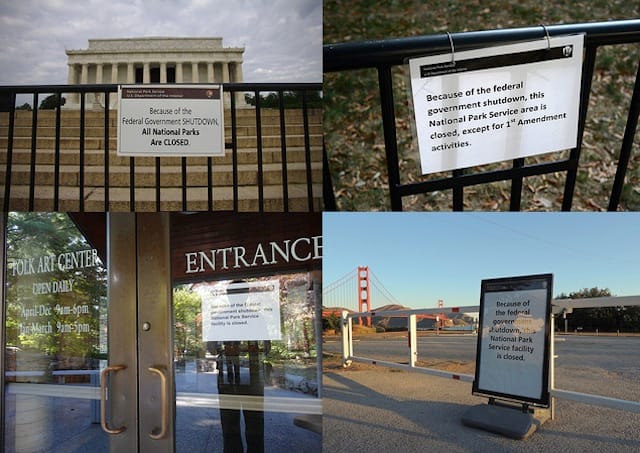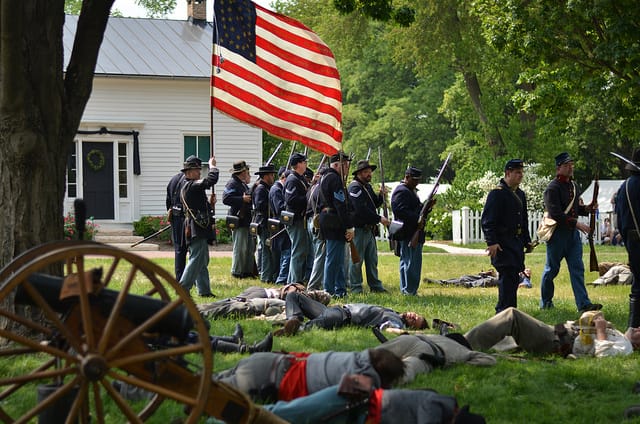Taking Stock of the Shutdown's Continued Impact on the Arts
The government shutdown has entered its third week, with little signs of an imminent resuscitation. When that happens, a full accounting of the impact will be done. But in the meantime, the shutdown lingers, and its effects continue to be felt.

The government shutdown has entered its third week, with little signs of an imminent resuscitation. When that happens, a full accounting of the impact will be done. But in the meantime, the shutdown lingers, and its effects continue to be felt.
For those who need to know, we present here an interim report of the shutdown’s impact on culture and the arts.
The following institutions in the Washington D.C. area remain closed with the exception of the American Indian Museum and Cooper-Hewitt, National Design Museum in New York and the Presidential Libraries in their various states:
Museums
- National Gallery of Art and the Smithsonian’s 19 museums, galleries, and one zoo (the National Zoo, African American History and Culture Museum, African Art Museum, Air and Space Museum, American Art Museum, American History Museum, American Indian Museum, Anacostia Community Museum, Arts and Industries Building, Freer Gallery of Art, Hirshhorn Museum and Sculpture Garden, Natural History Museum, Portrait Gallery, Postal Museum, Renwick Gallery Sackler Gallery Smithsonian Institution Building.)
- The Hirshhorn’s Twitter account has become a clock of the absurd, announcing each day during its closure a forever unchanging message
Due to the federal government shutdown, the Hirshhorn is closed. Museum programming and events are also canceled.
— hirshhorn (@hirshhorn) October 15, 2013
Libraries
- National Library of Medicine, National Agricultural Library, National Library of Education, National Archives, Library of Congress (Access to many of the websites maintained by the LoC has been restored restored, sans updates until government funding is restored.)
Their closings have had different effects, ranging from being simply closed to visitors to obstructing historical research to actually obstructing history:
- Academic research across the country and the world has been impeded due to limited access to federal libraries, databases, and their websites during the shutdown.
- The arrival of a Tyrannosaurus rex skeleton, originally slated to be delivered this month to the National Museum of Natural History, has been pushed back until next spring.
- The Diaghilev and the Ballets Russes, 1909–1929: When Art Danced with Music show at the National Gallery of Art and the Hirshhorn’s Peter Coffin: Here and There both ended their shows in the dark.
- The National Portrait Gallery’s Dancing the Dream show, scheduled to open October 4, has not opened.
- A number of National Portrait Gallery events have been cancelled, including a book talk and signing with author Jill Lepore for her Book of Ages, a celebrated biography of Benjamin Franklin’s sister, and the premier performance of a dance piece by a D.C. area company.
Both the National Endowment for the Arts and the Humanities remain shuttered, meaning NEA grantees will continue to experience “a lapse in appropriations” while new applicants will have to wait. The Copyright Office’s website is also down, so, no, you cannot Copyright The Budget Shutdown In Washington.

There is some good news amid all the dark reports:
- Responses to furloughed government employees have been worthy of cheers (Rep. Randy Neugebauer of Texas being a lamentable exception). Free offers have been extended to the some 800,000 with no money coming in and a long of time on their hands, including free popcorn, free admission to the Museum of the Moving Image, and free intro to knitting classes from a craft and knitting shop in Alexandria, VA.
- A variety of art events staved off cancellation through quick, creative thinking, including Philadelphia’s Mural Arts Program’s 30th anniversary and number of events at the Freer and Sackler Gallery.
- Some museums, like the Gibbes Museum of Art in Charleston, South Carolina have seen business really pick up.
But it’s largely overwhelmed by the bad news:
- This is because nearby Fort Sumter is closed, redirecting disappointed visitors to the Gibbes Museum’s excellent “Photography and the American Civil War.”
- Permits to film in Angeles National Forest, the L.A. River and Sepulveda Dam, popular outdoor Los Angeles County locations, have been suspended.
- At least one Civil War reenactment has been cancelled.
- 10 ArtPrize entries participating in the Grand Rapids event did so beyond visitors’ vision, locked away in the Gerald R. Ford Presidential Museum. Needless to say, this put a few artists in an undesirable spot, particularly John “Solly” Sollinger, whose glass mosaic “Snowfell”, under lock and key, was also scheduled to participate in a Ravenna, Italy mosaics exhibition beginning October 13. (In a email with Hyperallegric, Sollinger confirmed he was able to free his work in time, thanks to some help from the museum staff.)
- Film societies and theaters like the Northwest Chicago Film Society may find their programming interrupted as 35mm prints they often borrow from the Moving Image, Broadcasting, and Recorded Sound Division of the Library of Congress will not be delivered during the shutdown.
- The Washington Post contends the shutdown is even worse for D.C. Museums than meets the eye, citing the loss of gift shop proceeds and potential donor contributions.
Not the end of the world. Lab mice may perish by the thousands in National Institute of Health facilities, the White House’s garden harvest is moldering, and thousands of American seniors are worrying about their next meals. Oh, and the government may soon run out of money, either October 17 or November 1. Good timing for Alain de Botton to come out with Art as Therapy. We may all need it.




